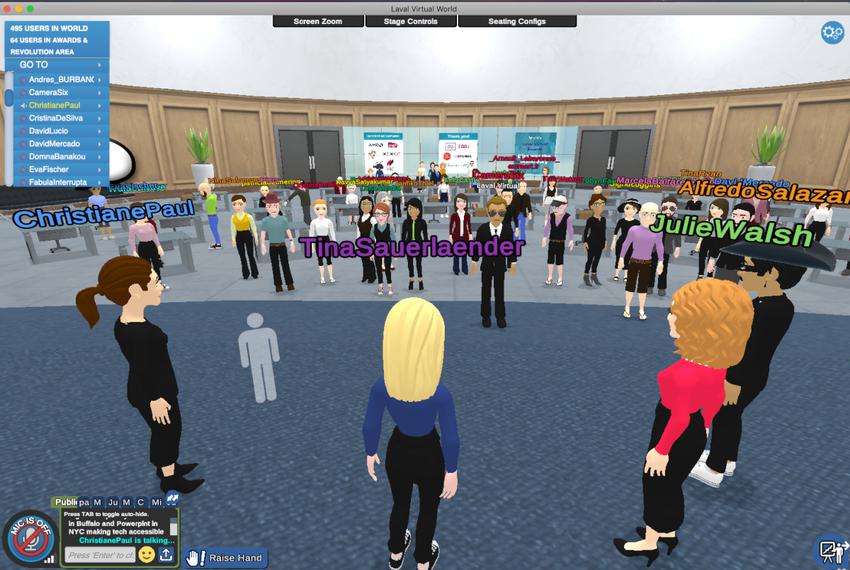Sustainability, Consultation
Björn Barutzki: "We see ourselves as cultivators"
What sustainability advice and services are available for Berlin companies …

For weeks everything was closed: the museums, theaters, cinemas and concert halls, the opera houses and design studios, bars, clubs and galleries. Doors closed - and then again not. Because many defy the shutdown. They are moving from the analogue to a virtual world. They continue where they left off before the crisis - only on the net. In a new series we will be presenting this New Virtual Reality in the coming weeks and months: What does it look like? How does it feel? How does Corona change offline formats? Today: Art and conferences using the example of curator Tina Sauerländer.
Tina Sauerländer's avatar has long blonde hair and is dressed in a navy blue sweater and black pants - almost like Tina Sauerländer in her normal life. But what is normal in times of Corona? The busy curator has been on the road a lot in recent years, "too much even", she sighs on the phone. Exhibitions, cultural events, workshops, vernissages, finissages, meetings with artists and organizers, conferences - all the things a busy curator does. Now social life came to a stop and with that the restlessness as well. However, she has worked from home most of the time anyway, zoom meetings are nothing new to her.
Tina Sauerländer is no stranger to Berlin. In 2010 she launched the platform peer to space, through which she makes digital and VR art accessible to a broad audience. The technology of VR could become a part of the post-Corona era alongside online meetings. Tina Sauerländer, who continues to network even now, knows a thing or two about it. She took part in Laval Virtual, a three-day conference of the VR community, this year in April - as an avatar. The conference, which actually takes place every year in France, was unceremoniously moved to a virtual location. This was made possible by VirBELA, a San Diego-based company that focuses on the construction of virtual worlds. "The conference took place on a virtual island, there was even a beach," says Tina Sauerländer. Some 10,000 avatars moved around the island, listening to lectures, attending seminars, and making contacts: "Sometimes it was even easier to get in touch with people," says Tina Sauerländer. You could tell which person was behind an avatar by the flashing of their name above their head. Communication was possible by chat or verbally when facing each other. "You have to think of it like the virtual world of Second Life," says Tina Sauerländer. But VR glasses were not necessary. "I hope that more conferences will soon be held online and that not everyone will have to jet halfway around the world just to be there," she says.
What currently appears to be a funny Corona mood could become a trend in the future - especially with regard to sustainability aspects. There was 98 percent less passenger air traffic in April - and thus also less C02 consumption. Tina Sauerländer is aware of this. "That could remain so in the future, at least long-distance travel could be reduced significantly," she says. This would benefit our climate. Technically, however, the digital events would still need some polishing up. For example, the graphics of VirBELA's virtual worlds are still quite simple. All avatars have the same stature and age, only some externalities such as hair color, gender or color of clothing can be changed. Such a representation of a virtual island requires a very high computing power, a more realistic representation would consume significantly more resources. And more resources, of course, also means higher C02 emissions. A more detailed and individualistic graphic is technically possible in any case, as the online gaming community proves.
Online-Content should cost something. Because digital offerings are just as real as physical

Whether some conferences will also be held virtually after Corona in the future depends largely on demand and the priorities of the players - for example, with the prioritisation of climate protection. This would also increase the quality of the digital offerings. A greater demand would not only have to improve the technical part, but also solve the problem of financing. The Laval Virtual Conference, for example, would actually have cost admission, but the digital version was free. Who would have been willing to pay for it? "Online content has to cost something," says Tina Sauerländer with conviction. "Digital offerings are just as real as physical ones," she says. "After all, if you're holding a talk at a virtual conference, it's the same as the one on site. And if an artist shows a work on a museum website and its Instagram channel instead of the exhibition space, a fee is payable for it just as much. This already works for digital newspaper subscriptions or streaming services for music and films. Why not in the art field?
Just as digital art does not replace painting, the virtual world does not replace the physical one. But work and commitment are needed for both: digital art and painting, online and offline conferences
The curator knows what she's talking about. In recent years she has conceived and curated many exhibitions and events, including online exhibitions. But the problem here is exactly the same as with Laval Virtual in digital format: financing. There is little or no money to be made from online art and conferences. "Just as digital art doesn't replace painting, the virtual world doesn't replace the physical world either," emphasizes Tina Sauerländer. But work, commitment and a great deal of experience are prerequisites for both digital art and painting, online and offline conferences. Why is this no longer taken into account financially? Many digital formats in the art and cultural sector are faced with this fundamental problem. Only the games, film and book industries have so far been able to capitalise on the digitisation of cultural assets. The question is: what is art and culture and its makers worth to us? And how can a digital art market be brought together with climate issues?

Tina Sauerländer has long since answered this question and is already planning her next thing. The screening series "Pars Pro Toto", which she co-curated, can be seen online on peer to space since 1 May. These are artistic video works that are intimate mirrors of society in a different place. Personal stories that stand as part of the whole. In addition, as artistic director she is currently supervising a newly established VR art prize. In cooperation with the Contemporary Arts Alliance Berlin, the DKB is awarding five working grants for four months to artists working with VR; in addition, three VR art prizes with a total value of 12,000 euros will be awarded. It is a clear sign: Digital art is slowly moving into the focus of the mainstream, even though digital art can hardly keep up with the market. Perhaps that's why it's becoming a climate pioneer. It is the time for it. May the force be with her.
Category: Specials
Also a good read
Subscribe to our monthly newsletter!